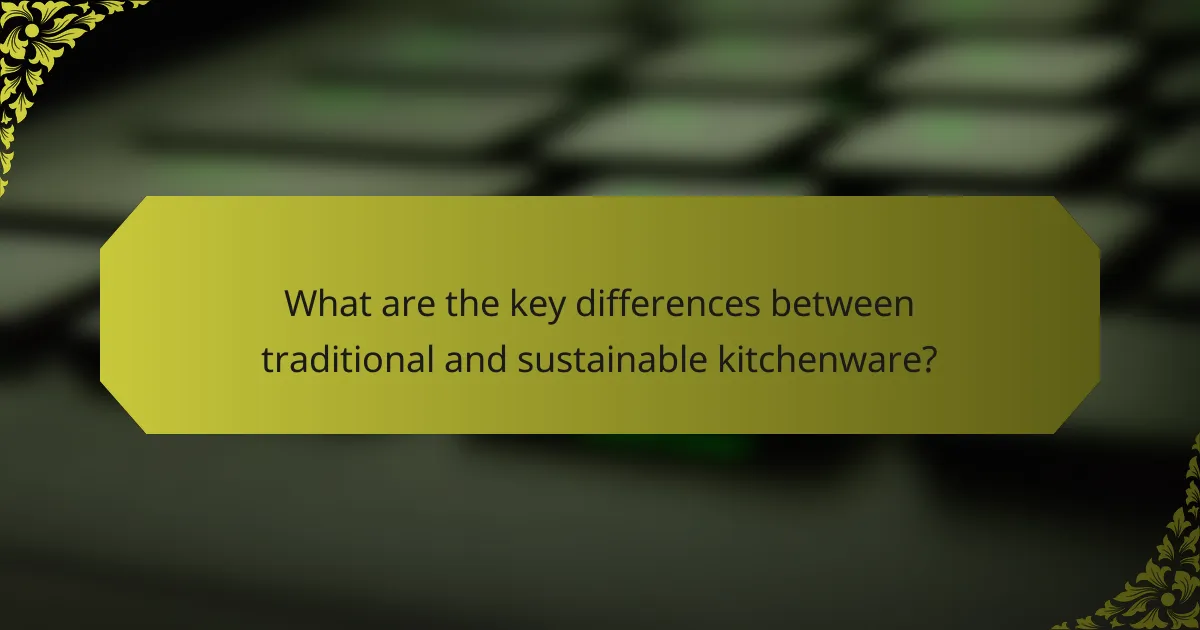The choice between traditional and sustainable kitchenware significantly affects the environment. Traditional kitchenware often contributes to plastic waste and high carbon emissions, while sustainable options prioritize eco-friendly materials and production methods. By understanding these differences, consumers can make informed decisions that promote both personal health and environmental sustainability.

What are the environmental impacts of traditional kitchenware?
Traditional kitchenware often contributes significantly to environmental issues, primarily through plastic waste, high carbon emissions during production, and potential health risks from toxic materials. Understanding these impacts can help consumers make more sustainable choices.
Plastic waste generation
Traditional kitchenware, particularly items made from plastic, contributes to substantial plastic waste. Many of these products are single-use or have a short lifespan, leading to increased landfill contributions and ocean pollution.
In the United States alone, millions of tons of plastic end up in landfills each year, with kitchenware being a notable part of this waste stream. Opting for reusable or biodegradable alternatives can significantly reduce this impact.
Carbon footprint of production
The production of traditional kitchenware often involves processes that emit high levels of carbon dioxide and other greenhouse gases. Manufacturing plastic and metal items typically requires significant energy, contributing to climate change.
For example, producing a single plastic item can result in emissions that vary widely, but many fall within the range of several kilograms of CO2. Choosing kitchenware made from sustainably sourced materials can help lower this carbon footprint.
Health risks from toxic materials
Many traditional kitchenware items are made from materials that can leach harmful chemicals into food. Plastics, particularly those containing BPA or phthalates, pose health risks that have raised concerns among consumers and health experts alike.
Using kitchenware made from safer materials, such as glass or stainless steel, can mitigate these risks. It’s advisable to check labels for safety certifications and to avoid products that do not disclose their material contents.

How does sustainable kitchenware reduce environmental impact?
Sustainable kitchenware reduces environmental impact by utilizing eco-friendly materials and production methods that minimize waste and pollution. These products are designed to be biodegradable, lower carbon emissions, and promote healthier living, contributing to a more sustainable lifestyle.
Biodegradable materials
Biodegradable kitchenware is made from natural materials that break down over time, unlike traditional plastic products that can persist in landfills for hundreds of years. Common biodegradable options include bamboo, cornstarch, and recycled paper, which can decompose within months under the right conditions.
When choosing biodegradable kitchenware, look for certifications that indicate the product meets compostability standards, such as ASTM D6400 or EN 13432. This ensures that the materials will break down effectively in commercial composting facilities.
Lower carbon emissions
Sustainable kitchenware typically has a smaller carbon footprint compared to conventional options. This reduction is often achieved through responsible sourcing, energy-efficient manufacturing processes, and the use of renewable resources. For instance, products made from bamboo grow quickly and require less energy to process than plastic alternatives.
To further lower carbon emissions, consider purchasing kitchenware from local manufacturers. This reduces transportation emissions and supports the local economy, making your kitchenware choices more environmentally friendly.
Healthier alternatives
Sustainable kitchenware often contains fewer harmful chemicals compared to traditional materials, making it a healthier choice for both consumers and the environment. For example, many sustainable products are free from BPA, phthalates, and other toxic substances commonly found in plastics.
When selecting healthier kitchenware, prioritize items made from glass, stainless steel, or certified organic materials. These options not only reduce exposure to harmful chemicals but also tend to be more durable and long-lasting, providing better value over time.

What are the key differences between traditional and sustainable kitchenware?
Traditional kitchenware typically relies on materials and manufacturing processes that have a higher environmental impact, while sustainable kitchenware focuses on eco-friendly materials and practices. Understanding these differences can help consumers make informed choices that benefit both their health and the planet.
Material composition
Traditional kitchenware often includes plastics, non-stick coatings, and metals that may contain harmful chemicals. In contrast, sustainable kitchenware is made from natural, renewable materials such as bamboo, glass, and stainless steel, which are less harmful to the environment. When choosing kitchenware, look for certifications like FSC for wood products or BPA-free labels for plastics.
Longevity and durability
Traditional kitchenware may wear out more quickly due to lower-quality materials, leading to more frequent replacements. Sustainable kitchenware is designed for longevity, often using durable materials that withstand wear and tear over time. Investing in high-quality sustainable options can save money in the long run and reduce waste.
Recyclability
Many traditional kitchenware items are not recyclable and end up in landfills, contributing to environmental pollution. Sustainable kitchenware, on the other hand, is often designed with recyclability in mind, allowing consumers to dispose of items responsibly at the end of their life cycle. Check local recycling guidelines to ensure proper disposal of kitchenware materials.

What are the cost implications of choosing sustainable kitchenware?
Choosing sustainable kitchenware often involves higher upfront costs but can lead to significant savings over time. Understanding the financial implications requires considering both initial investments and long-term expenses associated with replacements.
Initial investment comparison
The initial investment for sustainable kitchenware can be noticeably higher than traditional options. For instance, eco-friendly materials like bamboo or stainless steel may cost 20-50% more than plastic or non-recyclable items. However, this cost reflects the durability and environmental benefits of sustainable products.
When evaluating options, consider the quality and lifespan of the items. Investing in a high-quality, sustainable set may save money in the long run compared to frequently replacing cheaper alternatives.
Long-term savings on replacements
Sustainable kitchenware typically lasts longer than traditional items, leading to lower replacement costs over time. For example, a well-made stainless steel pot can last for decades, while a plastic one might need replacing every few years. This longevity can translate to savings of several hundred dollars over time.
Additionally, many sustainable products come with warranties or guarantees, further reducing the risk of unexpected expenses. Choosing durable, sustainable options can be a wise financial decision, as they often pay off in the long run through reduced waste and replacement needs.

How can consumers make informed choices about kitchenware?
Consumers can make informed choices about kitchenware by understanding the environmental impact of different materials and products. This involves evaluating certifications, researching brands, and considering the lifecycle of kitchenware items.
Evaluating certifications
Certifications can provide valuable insights into the sustainability of kitchenware. Look for labels such as FSC (Forest Stewardship Council) for wood products, or BPA-free for plastics, which indicate safer and more environmentally friendly options.
Additionally, certifications like Energy Star or EcoLabel can signify that a product meets specific environmental standards. Familiarize yourself with these certifications to make better purchasing decisions.
Researching brands
Researching brands is crucial for understanding their commitment to sustainability. Check if the company has transparent sourcing practices, uses recycled materials, or has a take-back program for old products.
Online reviews and sustainability reports can also provide insights into a brand’s environmental practices. Consider supporting brands that prioritize eco-friendly production methods and ethical labor practices.

What are the trends in sustainable kitchenware in the US?
Sustainable kitchenware in the US is increasingly focused on eco-friendly materials, reducing waste, and promoting longevity. Consumers are gravitating towards products made from renewable resources, such as bamboo and recycled plastics, while also seeking items that minimize their environmental footprint.
Materials Used in Sustainable Kitchenware
Sustainable kitchenware often features materials like bamboo, glass, stainless steel, and recycled plastics. Bamboo is popular for its rapid growth and biodegradability, while stainless steel is favored for its durability and recyclability. Consumers should look for certifications like FSC (Forest Stewardship Council) to ensure responsible sourcing.
Design and Functionality
Modern sustainable kitchenware emphasizes both design and functionality, offering stylish options that do not compromise on performance. Many products are designed to be multi-functional, reducing the need for multiple items and thus minimizing waste. For instance, a bamboo cutting board may also serve as a serving platter.
Consumer Awareness and Education
There is a growing awareness among consumers about the environmental impact of their kitchenware choices. Educational campaigns and social media influencers are helping to spread information about the benefits of sustainable products. Shoppers are encouraged to research brands and their practices, looking for transparency in sourcing and production.
Regulations and Certifications
In the US, various certifications help consumers identify sustainable kitchenware. The USDA Organic label and the Green Seal certification indicate adherence to environmental standards. Familiarizing oneself with these labels can guide purchasing decisions and support brands committed to sustainability.



